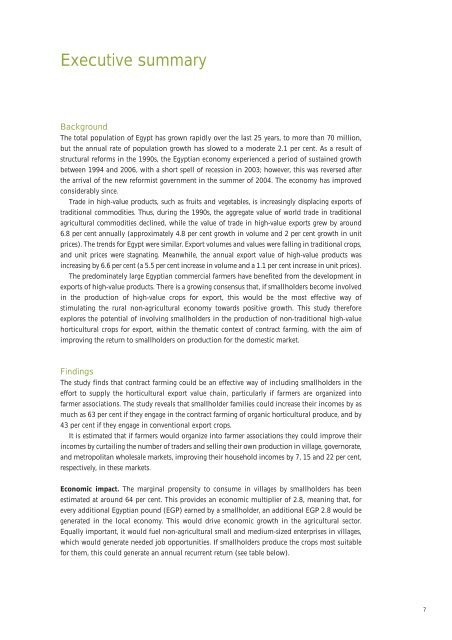Egypt: Smallholder contract farming for high-value and ... - IFAD
Egypt: Smallholder contract farming for high-value and ... - IFAD
Egypt: Smallholder contract farming for high-value and ... - IFAD
You also want an ePaper? Increase the reach of your titles
YUMPU automatically turns print PDFs into web optimized ePapers that Google loves.
Executive summary<br />
Background<br />
The total population of <strong>Egypt</strong> has grown rapidly over the last 25 years, to more than 70 million,<br />
but the annual rate of population growth has slowed to a moderate 2.1 per cent. As a result of<br />
structural re<strong>for</strong>ms in the 1990s, the <strong>Egypt</strong>ian economy experienced a period of sustained growth<br />
between 1994 <strong>and</strong> 2006, with a short spell of recession in 2003; however, this was reversed after<br />
the arrival of the new re<strong>for</strong>mist government in the summer of 2004. The economy has improved<br />
considerably since.<br />
Trade in <strong>high</strong>-<strong>value</strong> products, such as fruits <strong>and</strong> vegetables, is increasingly displacing exports of<br />
traditional commodities. Thus, during the 1990s, the aggregate <strong>value</strong> of world trade in traditional<br />
agricultural commodities declined, while the <strong>value</strong> of trade in <strong>high</strong>-<strong>value</strong> exports grew by around<br />
6.8 per cent annually (approximately 4.8 per cent growth in volume <strong>and</strong> 2 per cent growth in unit<br />
prices). The trends <strong>for</strong> <strong>Egypt</strong> were similar. Export volumes <strong>and</strong> <strong>value</strong>s were falling in traditional crops,<br />
<strong>and</strong> unit prices were stagnating. Meanwhile, the annual export <strong>value</strong> of <strong>high</strong>-<strong>value</strong> products was<br />
increasing by 6.6 per cent (a 5.5 per cent increase in volume <strong>and</strong> a 1.1 per cent increase in unit prices).<br />
The predominately large <strong>Egypt</strong>ian commercial farmers have benefited from the development in<br />
exports of <strong>high</strong>-<strong>value</strong> products. There is a growing consensus that, if smallholders become involved<br />
in the production of <strong>high</strong>-<strong>value</strong> crops <strong>for</strong> export, this would be the most effective way of<br />
stimulating the rural non-agricultural economy towards positive growth. This study there<strong>for</strong>e<br />
explores the potential of involving smallholders in the production of non-traditional <strong>high</strong>-<strong>value</strong><br />
horticultural crops <strong>for</strong> export, within the thematic context of <strong>contract</strong> <strong>farming</strong>, with the aim of<br />
improving the return to smallholders on production <strong>for</strong> the domestic market.<br />
Findings<br />
The study finds that <strong>contract</strong> <strong>farming</strong> could be an effective way of including smallholders in the<br />
ef<strong>for</strong>t to supply the horticultural export <strong>value</strong> chain, particularly if farmers are organized into<br />
farmer associations. The study reveals that smallholder families could increase their incomes by as<br />
much as 63 per cent if they engage in the <strong>contract</strong> <strong>farming</strong> of organic horticultural produce, <strong>and</strong> by<br />
43 per cent if they engage in conventional export crops.<br />
It is estimated that if farmers would organize into farmer associations they could improve their<br />
incomes by curtailing the number of traders <strong>and</strong> selling their own production in village, governorate,<br />
<strong>and</strong> metropolitan wholesale markets, improving their household incomes by 7, 15 <strong>and</strong> 22 per cent,<br />
respectively, in these markets.<br />
Economic impact. The marginal propensity to consume in villages by smallholders has been<br />
estimated at around 64 per cent. This provides an economic multiplier of 2.8, meaning that, <strong>for</strong><br />
every additional <strong>Egypt</strong>ian pound (EGP) earned by a smallholder, an additional EGP 2.8 would be<br />
generated in the local economy. This would drive economic growth in the agricultural sector.<br />
Equally important, it would fuel non-agricultural small <strong>and</strong> medium-sized enterprises in villages,<br />
which would generate needed job opportunities. If smallholders produce the crops most suitable<br />
<strong>for</strong> them, this could generate an annual recurrent return (see table below).<br />
7

















